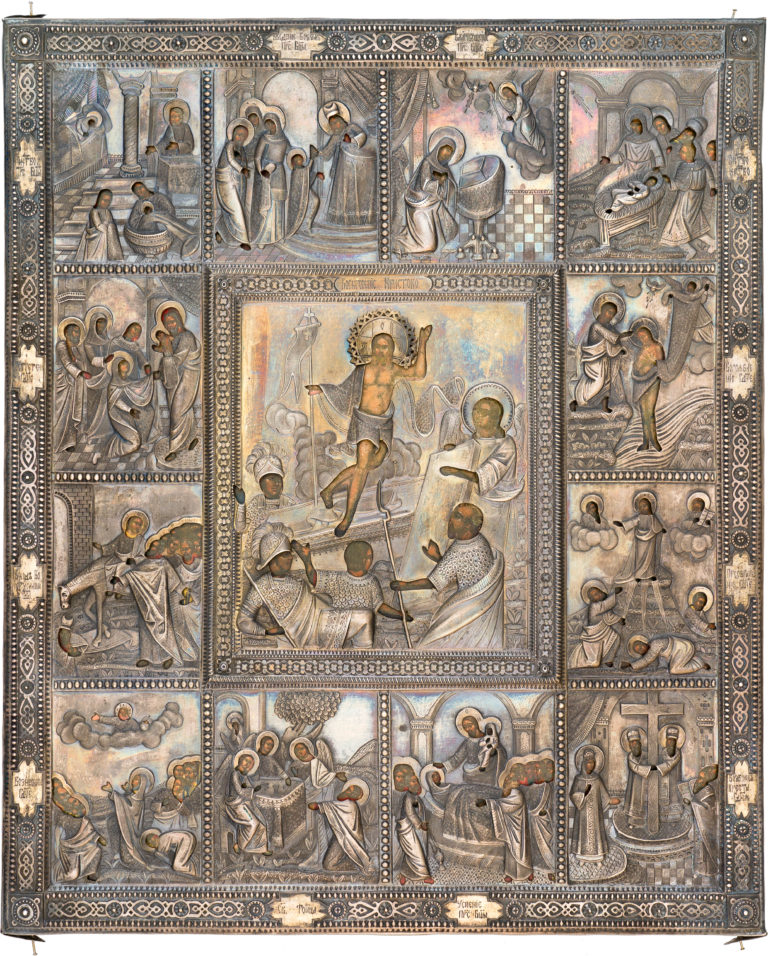The Resurrection, with Church Feasts in 12 Border Scenes
Antique Russian icon: last quarter – end of the 18th century. The Russian North (Vologda region).
Oklad cover: last quarter of the 19th century. St. Petersburg.
Size: 45 х 37 х 3 cm
Wood, absence of the incut centerpiece, underlying layer of canvas is not visible, gesso, mixed paint technique. The back of the antique icon is covered with velvet. Oklad cover: silver, embossing, engraving, etching, selective gilding.
Hallmarks and brands of the oklad cover: St. Petersburg coat of arms with the assayer’s mark “84” (last quarter of the 19th century); barely readable mark “ЕГ[Е]” – the hallmark of the unknown silversmith.
The author’s paintwork is in a satisfactory state. Chafing and restoration toning, fallouts of gesso on the borders of the hand-painted icon.
Contact us

The Resurrection, with Church Feasts in 12 Border Scenes
Diagram of the border scenes:
- The Nativity of the Mother of God;
- The Entrance of the Mother of God into the Temple;
- The Annunciation;
- The Nativity of Christ (The Adoration of the Magi);
- Candlemas (The Meeting of Christ in the Temple);
- The Theophany (The Baptism of Christ);
- The Entrance into Jerusalem;
- The Transfiguration;
- The Ascension;
- The Old Testament Trinity;
- The Dormition of the Mother of God;
- The Elevation of the Holy Cross.
The compositional and iconographic scheme of the given antique Russian icon attests to the artist’s orientation on Western European etchings and samples. The Resurrection of Christ depicted in the centerpiece of the hand-painted icon follows the Imperial-era variation known as the “Rising from the Tomb” – an image based on one of the etchings from Piscator’s Bible published at the end of the 17th century in the Netherlands. This version of the illustrated Bible, with its numerous etchings, was widely used by Russian religious icon painters in the 18th century. Closely following the original antique icons, the master depicts Christ half-naked, in white flowing robes, with His legs crossed, and a banner in His hands. Christ is surrounded by the amazed warriors who guarded His Tomb. The composition also includes the figure of the Angel holding the lid of Christ’s tomb. The overtly triumphant spirit of this scene appeared to be more in tune with the mood of the Imperial era and basically replaced the traditional Resurrection iconography – The Harrowing of Hades.
The iconographic scheme of the religious icon border scenes, the complex architectural details, the emotional posing of the figures, the composition of such scenes as “The Annunciation” – with the Archangel descending to Mary from a cloud, and “The Nativity of Christ” basically depicting the Adoration of the Magi and Herdsmen – all attest to the extremely powerful Western European influence. The iconography of other border scenes also reflects a new spirit of change and the disregard for the original Russian icon art tradition: in the Theophany scene, for example, we see the Angel holding a white piece of cloth over Christ’s loins.
The given antique Russian icon is a wonderful example of the late Baroque style of Eastern Orthodox iconography, which is reflected in the lively, emotional poses, the traditional thin, dark borders, and the color scheme built on the juxtaposition of various tones of blues and reds. Other stylistic traits – such as the clumsy poses, the emotional and draft-like manner of painting, the rather simple color work – all indicate that this hand-painted icon was created in the Russian province. The closest analogies are found in the Vologda and Veliky Ustyug regions in the last third and end of the 18th century. It was here, in the Russian North, that the Baroque traditions held out the longest and were adapted to blend in with the local folk culture.
The oklad cover for this antique Russian icon was made much later – in the last quarter of the 19th century in St. Petersburg. It is a wonderful example of the Neo-Russian style. Its ornamentation reflects the folklore tradition, the popularity of which is linked with the study and re-discovery of Russian wooden architecture that took place in that period. The retrospective spirit of the age is reflected in the introduction of the 17th-century Russian architectural motifs – the frame of the cover is decorated with open-work streams of geometric patterns reminiscent of traditional wood-carving. The ornaments are all clearly visible on the smooth metal surface due to the fine etching, which especially brings out the edges of the religious icon cover. The high-level of craftsmanship – evident in the execution of the saints’ vestments, which reflects every element of light and texture, the ethereal spirit of the clouds – testifies to the fact that the oklad cover for this antique Russian icon was devised by one of the best silversmiths of St. Petersburg.